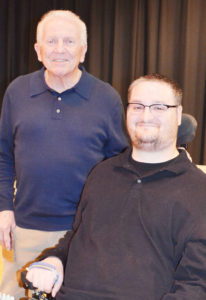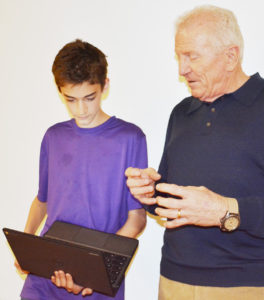~courtesy of The Scranton Journal

Making his first visit to speak to the high school students in Greene County, former astronaut Loren Shriver shared his experiences in space and urged the students to reach for the stars in whatever field they choose to study and work.
Charlie Hane of Jefferson, computer lab supervisor at the school, asked his uncle to share his experiences with the students.
Shriver was a member of the last class to graduate from Paton High School in 1962, one of 17 students that year. The school combined the next year as Paton-Churdan. He enlisted in the Air Force and was accepted into the AF Academy where he graduated in 1967. He says he always wanted to be a pilot and saw his opportunity through the Air Force.
However, he related later, that upon his graduation from the Academy, he had only flown in an airplane twice. He advanced through the ranks with hard work and study. Shriver served in Southeast Asia and Viet Nam in 1973-74.
He then began training as a test pilot and when NASA went looking for astronauts, Shriver was first in line to volunteer. That portion of his career spanned from 1978 until 1993 when he retired from active service, having served 27 years. He continued to work in the space industry at Kennedy Space Center and for United Space Alliance in Clear Lake, TX, until retiring in 2011.
Shriver and his wife (the former Diane Hane) now live in Estes Park, CO. He stated that although he’s retired, he’s becoming a regular on the “speaker’s circuit,” sharing his comments at schools, businesses and organizations.
Shriver flew three space shuttle missions. The first in 1985 was classified where he was the pilot. As far as he knows, that mission is still top secret and, as he joked with the students, “I have no intention of spending time in Leavenworth for discussing it now.”
He commanded the space shuttle missions in 1990 and 1992. Shriver shared his experiences from the 1990 shuttle mission by utilizing a short film where his crew was responsible for launching the Hubble telescope. He introduced the crew and explained what they did and how they did it.
The telescope is still being used today after 27 years. That mission received lots of publicity. Due to the international mission of the telescope, his family traveled to Paris, France where his wife and four children attended a large air show.
The 1992 mission was sponsored by the European Space Agency. Following that mission, the crew toured Europe for about three weeks. “It was one of the benefits of the mission,” noted Shriver.
The space flight sent him 33 nautical miles (388 miles in altitude) above the atmosphere. “I was able to watch the meteorites below me,” said Shriver. “It took a little bit to get used to.”
It takes tremendous velocity to get the space shuttle and its load into the air. “It’s a wild ride with 4.5 million pounds of payload taking 7.2 million pounds of thrust while reaching speeds of 17,500 miles per hour,” said Shriver.
That causes 1.5 G force on the body, with the space shuttle traveling once around the earth every 1.5 hours. The launch takes 8.5 minutes on the launch pad.
“It’s shaking and rattling around,” noted Shriver. “As a fighter pilot, I thought I knew a lot about flying but it’s such a different experience from normal flight.”
Astronauts are able to see a large portion of the earth’s surface. “The coasting speed is fast but you don’t get the sensation that you’re traveling that fast. You have to get used to it.”
Zero gravity in space causes everything to float. The astronauts have to be strapped in. To move, you push off and to stop, you hang on. “It takes a few hours to get used to but once you’re used to it, it’s such a blast!” Shriver added, “Once you experience it, I guarantee you would love it.”
He was most impressed by the views. “You can see so far, literally thousands of miles. The earth is such a beautiful place when seen from that altitude.”
The second mission, deploying the telescope, was a challenge. He admonished his team that if the 25,000 pound telescope was damaged “they’d be garnishing our pay for the rest of our lives.” They also ran several experiments in space.
Shriver commented that while in space, the astronauts’ legs feel very heavy. Even their hair felt heavy on their head.
“Five days of zero gravity is an experience you’ll never forget,” he explained. “I miss it. I volunteer as often as I can.”
The first mission to Mars is soon to be a reality, according to Shriver. He guessed 10 – 15 years from now is possible.
“You might be the right age for crew selection. I guarantee you’d enjoy the opportunity.”
The mission will probably be a minimum of two years in length because it will take six to eight months to fly to Mars and then the same amount of time to return.
“You’ll want to stay there and do something useful,” he advised. “It’s best to get started right now to get yourself qualified.”
He joked that for the first mission, they should send old people. “If they can’t make it back, nobody cares.”
Shriver says there is a space company that is interested in offering one way trips to Mars.
His longest mission in space was eight days. “There’s always risk in space flight,” he noted but added that he was comfortable with the experience.
One question asked by the students was about time in space. “Are days faster in space?”
“Yes,” replied Shriver, “theoretically.” He figures he’s a few nanno seconds younger than 72 years due to the time he spent in space. He also grew about an inch while in space due to the cartilage in his body expanding without the force of gravity. But he returned to his original height shortly after landing.
Shriver commented that now researchers are finding that people who have spent long periods of time in space are experiencing bone loss. Other changes occur in their eyes that affect their vision. Doctors are still checking on the effects of the radiation the astronauts have experienced.
While in space, the astronauts have a schedule with 16 waking hours and eight sleeping hours. But he never slept that long. “I was too pumped.”
In space they do things to prepare them to sleep. He found it easy to sleep for short periods. They sleep in sleeping bags that are pinned to the walls to hold them in place; otherwise they’d float around and wake up each time they bumped into something.
He didn’t get good REM sleep because his mind was always working. Shriver estimated three-four hours of pretty good sleep and then three-four hours of disturbed sleep was achieved each night.
Shriver was trained to do space walks but didn’t have the opportunity. NASA’s normal procedure is to cross train astronauts but the pilot and commander’s main jobs are to stay inside and operate the shuttle.

He signed up to be an astronaut. “It’s the most competitive thing. Start now if you want to be one!” He stressed “they evaluate your entire life. But that’s a fact of life in most any job.”
“Find something you really like to do, probably technical in nature,” Shriver offered. “Become good at it and work hard. You’re competing against the most amazing resumes.”
He has served on astronaut selection committees with thousands of applications to search through. He was lucky when he applied that NASA’s requirements were almost identical to his resume.
When he attended the Air Force Academy in the 1960s, he found that he was competitive in everything he did.
“Don’t let anyone ever tell you that because you’re from a small town in Iowa, that you can’t do something,” concluded Shriver. “With a little work, you can do it.”
